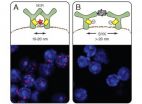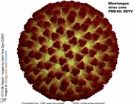(Press-News.org) This news release is available in German.
After a ten-year effort, Prof. Dr. Michael Reth from the Institute of Biology III of the University of Freiburg and the Max Planck Institute of Immunobiology and Epigenetics has developed a method to investigate the cell surface's organization on a nanometer scale. This allows him to monitor how the antigen receptor, which B cells of the immune system use to recognize foreign substances, changes after activation. This study shows that the receptor components dissociate from each other– rather than assemble, as previously assumed. Reorganization of receptors on the cell membrane takes place within a range of 10 to 40 nanometers. Under an optical microscope, however, it is only possible to distinguish objects that lie at least 250 nanometers apart. By using antibody fragments, so-called Fabs, Reth, speaker of the cluster of excellence BIOSS Centre for Biological Signalling Studies at the University of Freiburg, and his team improved the resolution of the previously developed proximity ligation assay (PLA) about 10 times. This technology allows the detection of molecules only when they are located in close proximity to one another. With the help of the more precise Fab-PLA method, the scientists were able for the first time ever to investigate on a ten-nanometer scale how receptors are distributed on the membrane and how they are reorganized. The Fab-PLA method is an important new instrument for the BIOSS Nanoscale Explorer Progamme (BiNEP), one of the research foci at the Cluster of Excellence BIOSS Centre for Biological Signalling Studies of the University of Freiburg.
When applied to the antigen receptors, the Fab-PLA method revealed red fluorescent dots on the cell membrane of inactive B cells: proof that the antigen receptors first appear on the membrane in groups, so-called receptor clusters. As soon as the B cells detected an antigen and were activated, however, the dots disappeared – the receptors had moved away from one another. This finding supports the dissociation model of B cell activation that was proposed by Michael Reth and Jianying Yang in 2010.
The researchers also demonstrated how the dissociation occurs: They deleted in B cells the gene encoding the signaling molecule Syk, a kinase that closely cooperates with the antigen receptor. On B cells without Syk the receptor clusters were still present after they had bound the antigen. Syk is thus the molecular key that opens the receptor cluster and initiates the immune response. In order to elucidate the further details of the activation of B cells, the researchers introduced Syk and the antigen receptor components into fruit fly cells. They modified Syk and determined that the cluster is not broken up until the molecule is bound to the inner part of the antigen receptor.
The researchers published their findings in the new open-access journal eLife. The study also included an investigation of the nanoscale organization of further receptors on B cells, including the CD19 or CD20 molecule. "We discovered that many receptors are organized on the membrane in specific areas at the nanoscale level," explains Kathrin Kläsener, PhD student and primary author of the study. The research was funded in part by an Advanced Grant for nanoscale analysis of protein islands on lymphocytes from the European Research Council (ERC), which Reth received in 2012.
INFORMATION:
Original publication:
Kathrin Kläsener, Palash C Maity, Elias Hobeika, Jianying Yang, Michael Reth, B cell activation involves nanoscale receptor reorganizations and inside-out signaling by Syk, eLife 2014.
More on Michael Reth's research:
http://www.pr.uni-freiburg.de/go/zellmembran_en
http://www.bioss.uni-freiburg.de/cms/index.php?id=100
Nanoscale ruler reveals organization of the cell membrane
Freiburg biologists measure distances and the arrangement of membrane molecules in nanometer range
2014-06-25
ELSE PRESS RELEASES FROM THIS DATE:
New study quantifies the effects of climate change in Europe
2014-06-25
If no further action is taken and global temperature increases by 3.5°C, climate damages in the EU could amount to at least €190 billion, a net welfare loss of 1.8% of its current GDP. Several weather-related extremes could roughly double their average frequency. As a consequence, heat-related deaths could reach about 200 000, the cost of river flood damages could exceed €10 billion and 8000 km2 of forest could burn in southern Europe. The number of people affected by droughts could increase by a factor of seven and coastal damage, due to sea-level rise, could more than ...
Using math to analyze movement of cells, organisms, and disease
2014-06-25
Traveling waves model tumor invasion
Cell migration, which is involved in wound healing, cancer and tumor growth, and embryonic growth and development, has been a topic of interest to mathematicians and biologists for decades.
In a paper published recently in the SIAM Journal on Applied Dynamical Systems, authors Kristen Harley, Peter van Heijster, Robert Marangell, Graeme Pettet, and Martin Wechselberger study a model describing cell invasion through directional outgrowth or movement in the context of malignant tumors, in particular, melanoma or skin cancer. Tumor ...
Freedom of choice: When rejection and discrimination hinder minority entrepreneurs
2014-06-25
When it comes to The American Dream, freedom of choice is a central value for entrepreneurs. According to a new study in the Journal of Consumer Research, when a person's choices are limited due to rejection and discrimination, they are more likely to fail at business and in their personal lives.
"Not only does restricting a person's choices threaten the success of a new business, it also has swift and damaging effects on the individual's self-esteem and their personal sense of control and power in the world," write authors Sterling A. Bone (Utah State University), Glenn ...
Money in the bank: Why does feeling powerful help people save more?
2014-06-25
In a materialistic culture, saving money is a challenge many of us face long before our retirement years. While many people think education, upbringing, and self-control are major contributors to a person's savings habits, a new study in the Journal of Consumer Research reveals that people save more when they feel powerful.
"We were interested in knowing whether the decision to save or not save money was affected by how someone was feeling during the time they were making a savings decision," write authors Emily N. Garbinsky (Stanford University), Anne-Kathrin Klesse ...
Army leads collaborative effort to establish standards for sequencing viral genomes
2014-06-25
Scientists at the U.S. Army Medical Research Institute of Infectious Diseases (USAMRIID) have proposed a set of standards aimed at developing a common "language" among investigators working to sequence viral genomes and characterize viral stocks.
According to USAMRIID senior author Gustavo Palacios, Ph.D., the proposed system, published last week as an editorial in the journal mBio, is the result of a collaborative effort involving scientists from many of the world's leading institutions. Contributors include the Broad Institute, the J. Craig Venter Institute, Los Alamos ...
Achieving Your Goals: Does removing yourself from the big picture help?
2014-06-25
Consider the case of the adult student attending night school to earn a degree that will result in a better job with higher pay. From sacrificing time with friends and family to missing a relaxing evening watching TV, this type of long-term gain often comes with short-term pain. According to a new study in the Journal of Consumer Research, people are more likely to achieve their goals and avoid temptations when they are able to remove themselves from the big picture.
"Past research on personal achievement has focused on whether someone sets nearsighted or farsighted ...
Distorting the past: Why do impulsive consumers forget their past indulgences?
2014-06-25
Activities like dieting, saving money, and studying require goal setting and self-control. But even the most disciplined person falls prey to temptation every once in a while. According to a new study in the Journal of Consumer Research, people who distort past memories of their indulgences are more likely to indulge in the future.
"We investigated the possibility that individuals may distort memories of past behavior in order to allow for indulgence in the present. In other words, people may trick themselves into thinking something like, 'I've been good on my diet lately, ...
Downside to disaster relief: Why do photos of attractive children backfire?
2014-06-25
When it comes to asking a stranger for help, being young, pretty, and the opposite sex greatly improve your odds. But when it comes to children suffering from the likes of natural disaster, poverty, or homelessness, a new study in the Journal of Consumer Research reveals that less attractive children receive more help than their cuter counterparts.
"Many charitable organizations use children in advertising and promotional materials. Our research examines how the facial attractiveness of the children in these campaigns affects the empathy and help received from adults," ...
Double standard? The use of performance-enhancing products
2014-06-25
When professional athletes are found to be using performance-enhancing drugs, many people consider this an unfair advantage and say they are cheating. But when another person uses the same drug to overcome a disease or behavioral issue, society is more forgiving. A new study in the Journal of Consumer Research shows that people are more forgiving when the benefit is personal.
"Our research shows that when people see others using ability-boosting products, they are more likely to see this behavior as morally unacceptable than if they were using the products themselves," ...
Marriage and healthy hearts
2014-06-25
PITTSBURGH—The affairs of the heart may actually affect the affairs of the heart in ways previously not understood.
"Growing evidence suggests that the quality and patterns of one's social relationships may be linked with a variety of health outcomes, including heart disease," says Thomas Kamarck, professor of psychology and Biological and Health Program Chair in the University of Pittsburgh Kenneth P. Dietrich School of Arts and Sciences. He is an author of a new study that correlates unhappy marital interaction with thicker carotid arteries and a higher risk of cardiovascular ...
LAST 30 PRESS RELEASES:
What determines the fate of a T cell?
Candida auris: genetic process revealed which could be treatment target for deadly fungal disease
Groundbreaking discovery turns household plastic recycling into anti-cancer medication
Blocking a key inflammatory pathway improves liver structure and vascular function in cirrhosis, study finds
Continuous spread: Raccoon roundworm detected in nine European countries
HKUST Engineering researchers developed a novel photodetector to enhance the performance of on-chip light monitoring
Strategic river sensors could have forewarned of Texas Camp flood disaster
Drone sampling of whale breath reveals first evidence of potentially deadly virus in Arctic
Roman soldiers defending Hadrian’s Wall infected by parasites, study finds
Pinochet’s prisoners were tormented with music but still found solace in it, a new book reveals
Fertility remains high in rural Tanzania despite access to family planning
AI-assisted device can improve autism care access
Kinetic careers
Uncovering how parasitic plants avoid attacking themselves to improve crop resistance
Nanoparticle vaccine strategy could protect against Ebola and other deadly filoviruses
Study finds brain care score can predict risk of stroke across racial groups
Key lung immune cells can intensify allergic reactions
Do hormones explain why women experience more gut pain?
New materials conduct ions in solids as easily as in liquids
Breakthrough of the Year: Renewable energy begins to eclipse fossil fuel-based sources
LLM use is reshaping scientific enterprise by increasing output, reducing quality and more
Introducing LightGen, a chip for ultra-fast, ultra-efficient generative AI
Astronomers see fireworks from violent collisions around nearby star
ACC/AHA issue new guideline on managing congenital heart disease in adults
Cosmic crash caught on camera
Is talented youth nurtured the wrong way? New study shows: top performers develop differently than assumed
Ants: An untapped resource in the development of antibiotics?
Archaeologists use AI to create prehistoric video game
Mitochondria migrate toward the cell membrane in response to high glucose levels
Tiny viral switch offers hope against drug-resistant bacteria
[Press-News.org] Nanoscale ruler reveals organization of the cell membraneFreiburg biologists measure distances and the arrangement of membrane molecules in nanometer range

